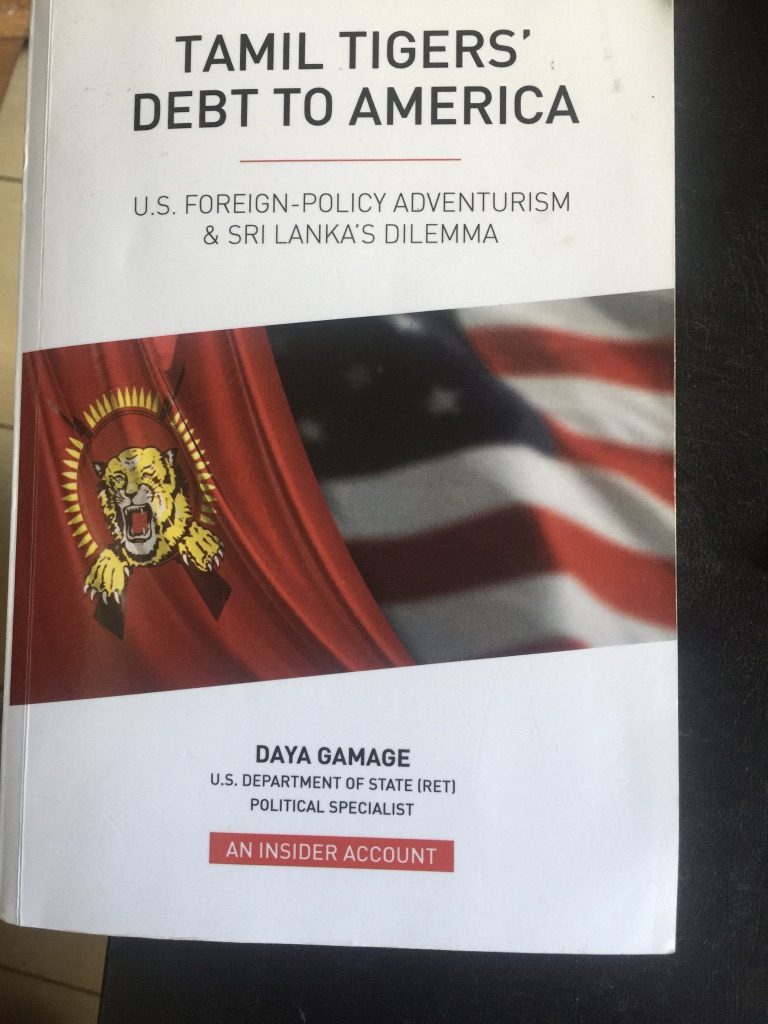
Daya Gamage worked at the American Embassy in Colombo, as the Sole Foreign Service National and as a Political Specialist. He retired in 1994 and have been living in Las Vegas since retirement. After two years of concentration, he has been able to share his knowledge, understanding and his intimate professional association with the US Department of State in the form of a book. Being extra careful as what to disclose or not, with his analysis and being aware of how America’s foreign policy worked, sometimes in a strange manner, he has come out with an unbiased text full of data in his book titled ‘Tamil Tigers’ Debt to America’. While assuring the facts contained in his book cannot be found anywhere else, Daya Gamage authorised the writer to “ to quote anything from his book”, so that that the readers will get a clear picture of America’s foreign policy, Sri Lanka’s national issues and the LTTE struggle in depth

On 17 August 2019, writer’s column in the Ceylon Today newspaper in Sri Lanka carried an introduction to a book written by Daya Gamage (picture above) under the title: ‘A book worthy of a read by all Sri Lankans”. The author of the book (‘Tamil Tigers’ Debt to America’) had worked at the American Embassy in Sri Lanka, with the Chief Political Officer in Colombo during 1989 and 1983. Having read Law at the University of Colombo, he was identified as the ‘Authoritative Source of Legal Analysis’ at the US Embassy in Colombo. While introducing the book, the writer had no access to Daya Gamage to seek his permission to quote from his text. However, a reader of the writer’s column-based in Canada helped the writer to contact Daya Gamage. Finally, a mutual agreement was reached to quote ‘ anything from the book so that that the readers will get a clear picture of America’s foreign policy, Sri Lanka’s national issues and the LTTE struggle in depth
American Policy Initiation
Daya Gamage begins his narration by explaining ‘how the American Policy shaped towards Sri Lanka’s National issues since the 1970s’. The excessive Sinhala domination of the Sri Lankan polity; declining of the Tamil influence in education; Trade and State Sector Employment since independence in 1948; the escalation of the Sinhala nationalism since 1956; Racial conflicts in 1977 and 1983 and finally the emergence of Tamil Tigers of Prabhakaran, have been the major causes for America to show an interest in the 11% of the Tamil population in Sri Lanka’s diverged society. It had been “the American desire to safeguard the rights of the ordinary Tamil people prior to defeating Tiger terrorism”.
In this regard, the American Ambassador to Sri Lanka ( 2006-2009) who held the position as Assistant Secretary for South Central Asian Affairs in Washington (2009-2013), Robert O. Blake, addressed the University of Madras in May 2008 summarizing the “ Carefully Developed” American policy towards Sri Lanka’s national issue by stating that “ One reason for the lack of recent progress on a consensus of the All Party Representative Committee (ARPC) document is that some Sri Lankan politicians believe that the Government should first defeat the LTTE and then proceed with a political solution”.However, he emphasised that the United States view was that ‘Sri Lanka government could further isolate and weaken the LTTE if it articulates now for a political solution
Daya Gamage worked at the American Embassy in Colombo, as the Sole Foreign Service National and as a Political Specialist. He retired in 1994 and have been living in Las Vegas since retirement. After two years of concentration, he has been able to share his knowledge, understanding and his intimate professional association with the US Department of State in the form of a book. Being extra careful as what to disclose or not, with his analysis and being aware of how America’s foreign policy worked, sometimes in a strange manner, he has come out with an unbiased text full of data in his book titled ‘Tamil Tigers’ Debt to America’. While assuring the facts contained in his book cannot be found anywhere else, Daya Gamage authorised the writer to “ to quote anything from his book”, so that that the readers will get a clear picture of America’s foreign policy, Sri Lanka’s national issues and the LTTE struggle in depth
This message in recent times was adhering to longstanding US perspective ‘as to what status the minority Tamils needed to achieve in Sri Lankan society, and how the Sinhala-dominated Sri Lankan polity should help them to achieve that status. This method demanded the political/administrative structure to make necessary arrangements in order that the two groups could share a mutual commitment to work towards an overall national development in terms of the rule of law, good governance and civil liberties that had been a line of policy developed in the 1980s initially at the American Embassy in Colombo, originated by Kenneth M. Scott, the Principal Political Officer at the Embassy.
“ Near-Midlevel Security Clearance”.”
Daya Gamage managed to complete the book with “ a near-midlevel security clearance” in a crowded political section occupied by Foreign Service officers (FSOs). Gamage was the sole foreign service national (FSN) who was directly working with Chief of the Mission. He was able to closely witness and shape the American perspective towards Sri Lanka’s domestic issues taking into consideration race relations, ethnic tensions, minority rights and increasingly the Sinhala dominated polity, in an in-depth study to achieve a diversified understanding of those domestic issues. During this volatile period, Daya Gamage was privy to sensitive discourses that took place within the American Diplomatic Mission, in Colombo, which gave access to him to learn about American thinking patterns and values, and basically the American mindset.
Tamil Tigers became a threat
By the time Daya Gamage left the service in 1994, many issues emerged as critical national problems in the context of Tamil Tigers becoming a threat to the Sri Lankan polity, and caused protracted internal debates within the confines of the Colombo American Embassy, between 1980 and 1995. It was believed that an American policy concluded towards the grave national problems in Sri Lanka.
In 1995 the US State Department had come to the foregone conclusion of ‘what should be the “outline” of US policy towards the ‘Tamil issue” in Sri Lanka. The book states that ‘it is this self-same reading that now governs the conversations within the State Department and its official public pronouncements since the military defeat of the LTTE in May 2009. Significantly during these fifteen years (1980 to 1994) although the Ambassadors changed, every two to three years, there had been no lacuna in the development of this perspective.
Being an FSN ( Foreign Service National), Daya Gamage witnessed the ‘ unfolding and shaping of the American perspective towards Sri Lanka’s national issue, as the United States termed it at close quarters. In the debating traditions sustained in Service, Daya Gamage has often contributed towards the overall policy by challenging some of the concepts that the FSOs endeavoured to incorporate in the overall policy agenda.
Since the forefathers drafted the US constitution and made vital amendments, the US has adopted a system of allowing its subjects and officers to challenge the status quo, which provides space for the emergence of new ideas and concepts in its efforts a policy agenda it faces. Daya Gamage was an exception but enjoyed the broad and valued freedom within the State Department.
Author’s view Point.
Daya Gamage states that Sri Lanka needs to understand as to why the US holds certain views about Sri Lanka on issues that have led to misunderstandings between the two nations. He advises that in dealing with the United States, Sri Lanka and her close observers need to be aware of the US adheres to particular positions on a multitude of issues, interpreted by American FSOs and officials in Washington.
The author considers in his book on ‘Tamil Tigers’ Debt to America’ readers will develop an insider view, which may help Sri Lanka, Sri Lankan academics and writers to have a better understanding and a vision to US positions, and as to why the US adopts such positions, some of which are politically offensive to Sri Lanka and somewhat opposed to the populist politics that have dominated the nation since the mid 1950s.
A vital observation of the author is that since the formulation of the American policy towards Sri Lanka’s “national issue” from 1981, during FSO Kenneth Scot, into the next fifteen years ( 1995) was how the State Department reacted. FSOs stationed in Colombo and the department officials who visited Sri Lanka, from time to time, succumbed to the tales of outrages presented by the Tamil Lobby. This scenario, the author says, can be neatly summarised by using a pronouncement by the American Circus entrepreneur P.T. Barnum (of the 1980s) who once said: “ There is a sucker born every minute: There is no such thing as bad publicity and the more outrages you claim, more people will notice you and buy a ticket to your show”.
Tamil National Leaders.
When Sri Lankan Tamil national leaders of repute, namely Amirthalingam, Sivasithamparam, Yogeswesren, Sampathan and Susaithasan, all of whom were primary and valued contacts of the US Embassy in Colombo, drew the FSOs’ serious attention to the 1976 Vaddukkodai Resolution, Americans accepted it without realising it was only half -truth. FSOs became convinced that the Tamils had overwhelmingly endorsed the thrust for a separate state at the 1977 parliamentary general election. It was in this frame of mind that the Americans met officials of the Government of Sri Lanka (GSL) and other civic leaders.
Strangely, the GSL was unaware, or did not have the capacity to understand, the emerging mindset of the FSOs, and how the FSOs had been naïve in establishing their opinion about eleven per cent of the Tamil population had endorsed a separate state – even though in the 1977 parliamentary election Northern and Eastern Provinces gave a different picture. The FSOs also were developing an opinion that “ 11 per cent minority of Tamils did not enjoy the share that they should have enjoyed in many spheres in the Sri Lankan society, as a shared commitment with the majority of 74 per cent Sinhalese. The statistics, however, revealed that the share of the Tamils who had enjoyed at the time of Ceylon’s independence (1948) had drastically declined by the 1970s. This is what alerted and perturbed the Western diplomats.
Featured image: US Embassy in Colombo- The Author receiving one of USG’s highest recognitions, the Memorial Honour Award for super performance and Exceptional Professionalism in February 1989 from Ambassador Marion Creekmore.
Pic credit: Daya Gamage ( Google pics)
Courtesy Daya Gamage, Author of “ Tamil Tigers’ Debt to America”.H






